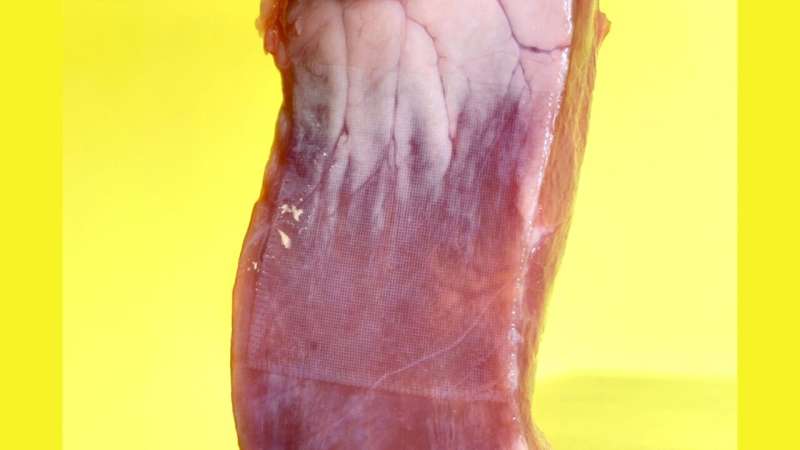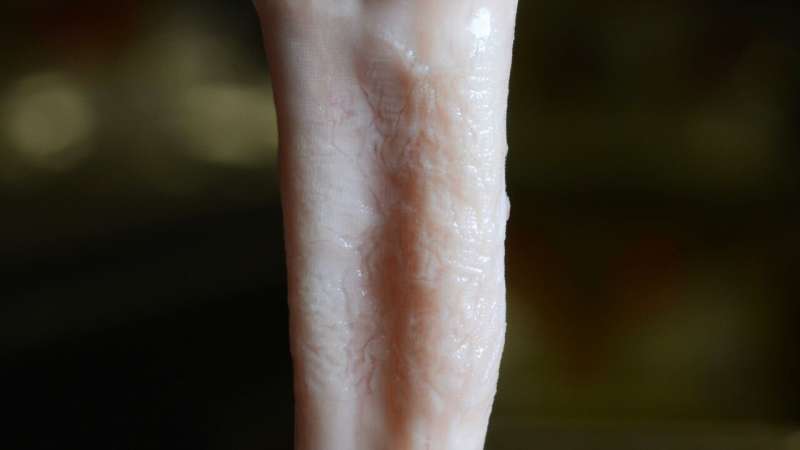February 22, 2024 feature
This article has been reviewed according to Science X's editorial process and policies. Editors have highlighted the following attributes while ensuring the content's credibility:
fact-checked
peer-reviewed publication
trusted source
proofread
3D-printable tissue adhesive sets a new standard in biomedical technology

Researchers from MIT have developed a 3D-printable tissue adhesive that demonstrates superior tissue adhesion, rapid sealing capabilities across various surgical scenarios and a unique blood-repelling feature. The technology holds immense potential for revolutionizing wound care and biomedical device applications.
The research has been published in Nature Communications.
Tissue adhesives provide alternatives to traditional wound closure methods like sutures and staples, offering advantages such as reduced tissue trauma, quicker application, and potentially minimized scarring.
Despite the effectiveness of traditional adhesives, their time-consuming, skill-dependent application and patient discomfort have prompted the quest for innovative solutions.
For instance, they might be less effective in sealing irregularly shaped or highly mobile tissues. Moreover, the application of traditional adhesives can be labor intensive, leading to extended surgical times. Additionally, these methods may cause tissue damage, and the materials themselves might not always integrate seamlessly with the body.
Innovations in tissue adhesives aim to overcome these drawbacks by providing more versatile, efficient, and patient-friendly solutions. The development of 3D printable tissue adhesives, as showcased in the MIT research, introduces a new dimension to wound closure and tissue repair.
Medical Xpress spoke to the first author of the study Sarah Wu, a Ph.D. candidate in the Department of Mechanical Engineering at MIT, working under the supervision of Professor Xuanhe Zhao. She said, "Our research group has been interested in developing tissue adhesive materials due to their potential to atraumatically seal and repair wounds.
"As a mechanical engineer, I've also been fascinated by 3D printing and the manufacturing versatility it provides. Thinking about the possibilities that 3D printable tissue adhesive could enable, such as customized patches and soft bio-integrated devices, motivated us to explore new material solutions."
Components and fabrication of the tissue adhesive
"Our research focused on developing a 3D printable tissue adhesive capable of creating custom-sealing patches and devices," said Wu.
The researchers formulated a tissue adhesive ink comprising poly(acrylic acid) grafted to polyurethane. This unique composition is crucial for providing strong adhesion to tissues, with specific chemical functional groups responsible for forming a secure bond with biological tissues.
To enhance its functionality, the team incorporated a blood-repelling hydrophobic matrix into the adhesive structure. The matrix acts as a protective barrier, crucial for preventing direct contact with bodily fluids and maintaining the adhesive's integrity, particularly in challenging conditions such as those found in bleeding tissues.
The intricate process commences with precision, as the tissue adhesive ink is 3D printed onto a hydrophobic-coated glass slide, creating a pattern with circular void spaces for electrodes. This coating plays a critical role in ensuring the adhesive's effectiveness, especially in the presence of bodily fluids.
A polyurethane-based insulator layer is then printed over the adhesive layer. This insulator layer enhances the adhesive's functionality and stability during application.
Following this, the researchers used silver conductive ink to 3D print electrodes and circuitry onto the structure. This step showcases the multifunctionality of the adhesive, allowing for the potential integration of electronic components if required for specific applications.
The researchers also added light-emitting diodes to the circuit using a small amount of silver ink. This addition vividly demonstrates the adhesive's versatility, suggesting potential applications in bio-integrated devices.
The fabricated bioelectronic patch is then adhered to an ex vivo porcine heart, and a power source is employed to run a current through the tissue, confirming the illumination of the LEDs and underscoring the bioelectronic capabilities of the adhesive.
With systematic precision, the researchers applied the fabricated patches to different tissue defects, subjecting them to a battery of tests. These include adhesion characterization, rheological and mechanical assessments, and biocompatibility studies conducted through a series of in vivo experiments on rats.

Unique feature: Blood-repellent infusion
The 3D printable tissue adhesive demonstrated remarkable superiority in tissue adhesion performance compared to existing commercial products. This achievement is underscored by its rapid tissue-sealing capabilities across various surgical scenarios.
During the research, an unexpected breakthrough emerged—the potential to infuse the adhesive with a blood-repellent fluid.
"The potential to infuse the porous structure of our printed adhesive with a blood-repellent fluid enabled adhesion even to heavily bleeding tissues. Most tissue adhesive materials commonly fail in bloody environments, making it difficult to achieve hemostasis," explained Wu.
The use of a protective hydrophobic matrix further enhanced the adhesive's functionality, creating a barrier that shields it from bodily fluids, crucial for maintaining its integrity, especially in challenging bleeding scenarios.
The blood-repellent infusion, a transformative feature, positions their 3D printable tissue adhesive at the forefront of biomedical materials. It addresses common challenges faced by existing adhesives in environments with significant blood flow, opening doors to diverse applications from wound closure to potential bio-integrated devices.
The bioadhesive, 3D-printed tissue patches showcased remarkable strength and toughness across multiple tissues. Mechanical tests demonstrated their resilience to shear forces, burst pressures and tensile loads, indicating suitability in diverse physiological environments.
Biocompatibility studies confirmed their safety, with minimal cytotoxicity observed, and in vivo models, including trachea, colon, liver, and femoral artery repairs, show successful adhesion and integration into the surrounding tissue.
Micro-CT imaging provided quantitative insights into tissue regeneration post-surgery, establishing the robustness and effectiveness of these patches.
Tissue-interfacing devices and tissue-repair solutions
The capabilities of the 3D printable tissue adhesive could not only revolutionize wound closure but also hint at expansive applications in various tissue-interfacing devices.
Wu explained, "Due to its versatile manufacturing capabilities, our 3D printable adhesive could be utilized in a range of biomedical devices, including sensors and drug delivery systems.
"For instance, it may enhance the stability of bio-integrated sensors by providing a reliable interface for signal transfer. Similarly, it can facilitate localized drug delivery to tissues."
The researchers hope to focus on soft tissue–interfacing device development, with the adhesive as a pivotal component, in the future.
"Leveraging the 3D printability of our material opens up exciting possibilities for designing patches with tissue-specific properties, paving the way for more personalized tissue-repair solutions," concluded Wu.
More information: Sarah J. Wu et al, A 3D printable tissue adhesive, Nature Communications (2024). DOI: 10.1038/s41467-024-45147-9
© 2024 Science X Network




















